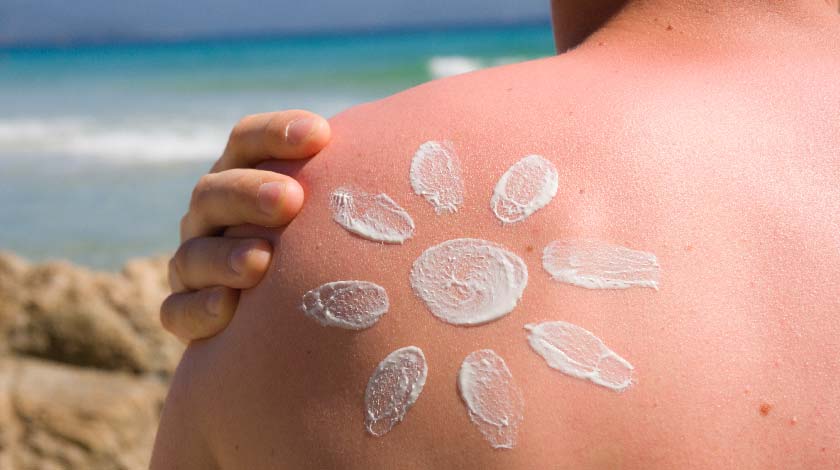The skin is the largest organ in the body, and its job is to provide protection from environmental elements – including the sun. Sunshine has two different types of ultraviolet (UV) rays, UVA and UVB.
UVA and UVB
1. UVA is responsible for aging the skin by getting through to the deeper layers and causing wrinkles to develop.
2. UVB is the cause of sunburn. These rays can damage the skin cells, causing red, raw, and peeling skin.
Excessive exposure to ultraviolet rays, particularly starting from a young age, is the main cause of melanoma and nonmelanoma skin cancer.2
Who is at risk? Everyone.
- Redheads or fair haired individuals
- Those with blue, green, or hazel eyes 3
- Those with many moles or freckles
- Anyone with over 100 moles is at a greater risk of melanoma and should be extra cautious during sun exposure 4
- Ethnically darker skin is less likely to burn, but can still age prematurely by too much sun exposure 5
Protection against UV exposure

- Any exposure, either from sunlight or artificial sunbeds, can cause damage to the skin5,6
- Natural sunlight is often hard to avoid, putting on sunscreen with Sun Protection Factor (SPF) of at least 30 (and that offers UVA, as well as UVB protection) is recommended
- Avoid direct sunlight between the hours 11am and 3pm during the hottest seasons and year-round in tropical areas
- The strength of UV rays is significantly increased in high altitude areas; it can be reflected from snow or white sand 5
- Cloud cover offers very little protection, so does swimming in water since the harmful UV rays can still penetrate to our skin in these conditions 5
Other precautions people can take include [anyone below - at least 3]
- Seeking out deeper shades, such as from buildings or dense trees
- Wearing clothing that covers as much skin as possible
- Wearing a wide-brimmed hat to protect scalp, face, neck and ears and wearing sunglasses to protect the eyes
- Reapplying sun protection generously and regularly throughout the day, and at least 30 minutes before sun exposure 5
- Wearing fabrics specifically designed to provide protection from high ultraviolet light are a good option too
Experts recommend that absolute sun avoidance is not necessary:
- Short bursts of sun exposure below the burning range is recommended
- Suitable precautions are necessary to maintain appropriate vitamin D levels within your body.8
Warning signs of melanoma
Moles, freckles and brown spots are normal and are usually harmless. However, some can develop into skin cancer.
The Skin Cancer Foundation recommends following the ABCDE signs of melanoma, these are outlined as:
- A – Asymmetry: Benign moles are usually symmetrical. A warning sign for melanoma is if a mole or freckle is asymmetric
- B – Border: A benign mole will usually have smooth, even borders. An early sign of melanoma is if a mole or freckle has scalloped or notched edges
- C – Color: Benign moles are usually the same shade of brown. If the colour changes, or shades vary within the freckle or mole, this can be a warning sign
- D – Diameter: A mole or freckle that is larger than 6mm in diameter can be a warning sign of melanoma
- E – Evolving: Benign moles look the same over time, and will stay the same shape, size and color. However, if you notice any changes in your freckles or moles, or it starts to itch, bleed or starts to crust over, it is a warning sign 4
If you notice any of the above signs, you are recommended to visit the healthcare professional.
Sources
- Skin Cancer Facts & Statistics. Skin Cancer Foundation. Visited July 8, 2016.
- El Ghissassi F, Baan R, Straif K et al (2009) WHO international agency for research on cancer monograph working group. A review of human carcinogens - part D: radiation. Lancet Oncol 10:751-2.
- Skin cancers. World Health Organization. Visited July 8, 2016.
- Do you know your ABCDEs? Skin Cancer Foundation. Visited July 8, 2016.
- British Photodermatology Group Position Statement on Sun Awareness and Safety. British Association of Dermatologists. Visited July, 8 2016.
- Diffey BL (2003) A quantitative estimate of melanoma mortality from ultraviolet A sunbed use in the U.K. Br J Dermatol 149:578-581.
- Gies, P. (2008) Photoprotection by clothing. Photodermatology Photoimmunology and Photomedicine 23(6):264-74
- Rhodes LE, Webb AR. Fraser HI, et al (2010) Recommended summer sunlight exposure levels can produce sufficient (> or =20 ng ml(-1)) but not the proposed optimal (> or =32 ng ml(-1)) 25(OH)D levels at UK latitudes. J Invest Dermatol 130:1411-1418.

